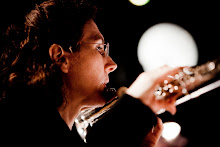In other words, a measure can be interpreted as an "area of activity". The level of activity can easily be reckoned using the starting tempo. From there we can calculate the length of any measure or individual note through simple mathematics.
So if the rhythm cannot be felt as a pulse, one can at least memorize the speed in which it is supposed to happen. Surprisingly, it's sometimes much slower than one thinks!
Ferneyhough's Superscriptio for solo piccolo is a good example. The basic tempo is an eighth-note at 56. This means a whole note in 4/4 equals 7, because there are 8 eighth notes in a 4/4 bar, and 8 divided by 56 = 7.
From this number 7 you can deduce all the "odd" time signatures that are not based on divisions of the eighth note. An eighth note quintuplet (or a "1/10" bar) will equal 70 because there are 10 quintuplets in a 4/4 bar (7 x 10 = 70). To find the length of a 3/10 bar you would divide 70 by 3. If you have a 5/10 bar you would divide 70 by 5. An eighth note triplet (or a "1/12" bar) will equal 84 because there are 12 triplets in a 4/4 bar (7 x 12 = 84). To find the length of a 3/12 bar you would divide 84 by 3, and to find the length of a 5/12 bar you would divide 84 by 5.
What if the compound rhythms are stacked on top of each other, as in Ferneyhough's other works? This is an imaginary example:
 Let's imagine as in Superscriptio the starting tempo is an eighth-note at 56. The last six 16ths (at the end of the bar) roughly equal two 16th-note triplets at 64. The nine 32nds under the 9:5 are roughly equal to three sets of 32nd triplets going at 116.
Let's imagine as in Superscriptio the starting tempo is an eighth-note at 56. The last six 16ths (at the end of the bar) roughly equal two 16th-note triplets at 64. The nine 32nds under the 9:5 are roughly equal to three sets of 32nd triplets going at 116.It could have been notated thus (among other possibilities):

Here's the math:
From above we know that a 1/10 bar equals 70.
A 4/10 bar will equal 17.5 (70 divided by 4 = 17.5).
Each 11-tuplet will be 192.5 (17.5 x 11 = 192.5).
There are 6 of these 11-tuplets at the end. If we think of them as two 16th-note triplets, divide 192.5 by 3 = ca. 64
5 of those 11-tuplets equals 38.5 (192.5 divided by 5 = 38.5).
In the 9:5, if you think of the 9-tuplets as 3 sets of 32nd triplets, those triplets go at ca. 116 (38.5 x 3 = 115.5)
A click track will ensure accuracy without a doubt. However, if you opt for another approach, try the following: memorize the speed of each bar by practicing related bars together. Keeping Superscriptio as an example, you can practice all the bars based on "1/12" while keeping the metronome at tempo 84. (Yes, you will be jumping from measure to measure, or page to page.) Then do the same for all the "1/10" bars, then "1/8" etc. You are not trying to achieve musical continuity yet, this is just an exercise to help relate all the bars with this tempo, and to keep them consistent. When you finally put the piece together, your "internal conductor" will hopefully have a kinesthetic memory of the pulse of each measure and make the tempo changes accordingly.
Also see my post Seminar with Brian Ferneyhough.
Other thoughts?





